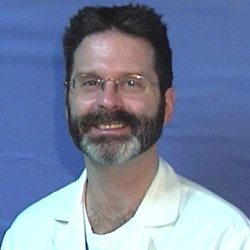 |
Anthony Adelson, M.D. |
“I’ve worn pants for so long now, the cosmetic piece is neither here nor there,” Muirhead said.
It’s the dull ache and occasional jolting pain in her legs when she accidentally bumps against one of the veins that bother her most.
That was until recently when Muirhead underwent a new, less-invasive procedure to alleviate varicose veins performed by Anthony Adelson, M.D., an associate professor and section head of interventional radiology at UNMC.
Endovenous laser treatment is a simple, non-surgical procedure performed right in the office.
“Most patients are walking within minutes after the procedure, no anesthesia is used, just some Valium to calm the nerves and they are back to work the next day,” Dr. Adelson said.
Traditionally varicose veins are eliminated by a surgical procedure that requires the removal of the greater sapheneous vein from the groin to the knee while the patient is under anesthesia. Or fluids are injected into the problem veins causing them to collapse.
But these methods don’t always correct the problem, Dr. Adelson said.
“The body will find another passage in which to route the blood by sending it to other veins that connect to this larger vein, thus the patient is often coming back to be retreated,” he said.
The first step in treating varicose veins using the endovenous laser procedure is to locate the source of the problem with an ultrasound scan of the leg.
The procedure takes about an hour and involves inserting a small tube into the affected vein. A laser is then used to collapse the vein from the inside, he said.
The veins that become varicose are located in the fatty tissue of the leg, Dr. Adelson said.
These superficial veins play an insignificant role overall and so it doesn’t matter if they are collapsed, he said.
More than 40 percent of women and 25 percent of men suffer from varicose veins.
The most common cause of varicose veins is malfunctioning valves that normally restrict blood from continuously flowing down the leg.
When the valves don’t work, blood is allowed to flow freely in the wrong direction, causing the veins to expand and/or divert to other, smaller veins.
“Once the source of the problem is eliminated, so are the symptoms,” Dr. Adelson said.
Muirhead is just glad she isn’t living with a constant ache in her leg.
“My sister had hers stripped three times and she was laid up in bed for weeks afterwards,” she said. “I always swore I would wait for something better. This is so simple and painless. I would recommend it to anybody.”